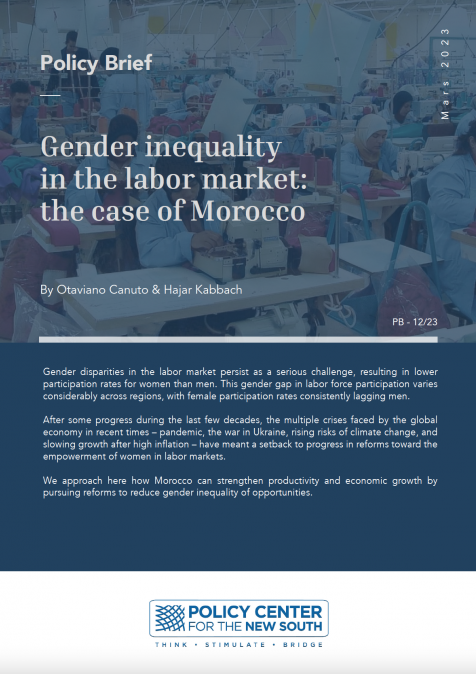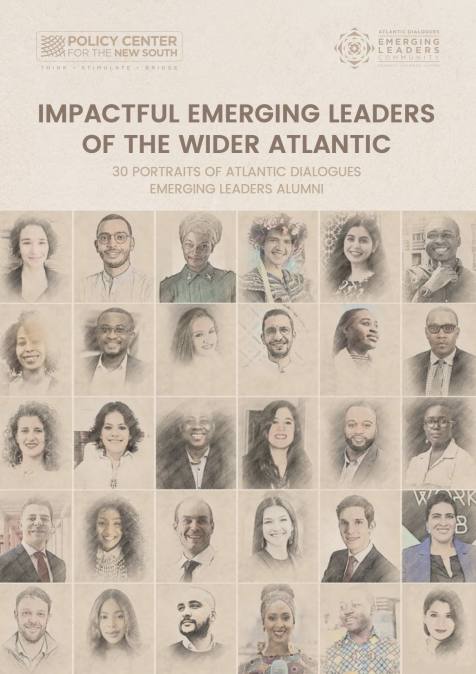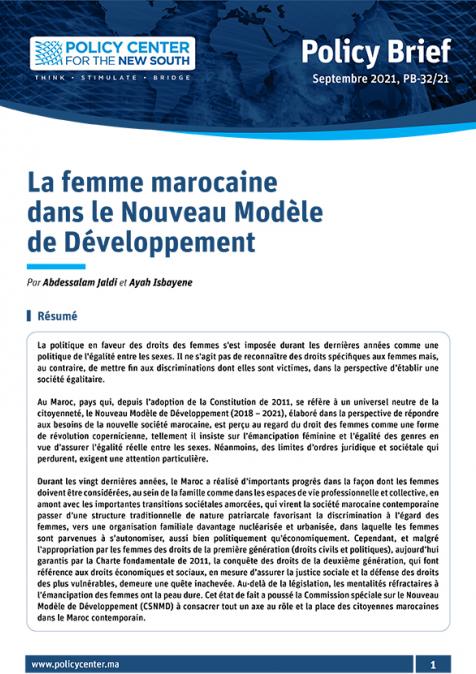Publications /
Policy Brief
Gender disparities in the labor market persist as a serious challenge, resulting in lower participation rates for women than men. This gender gap in labor force participation varies considerably across regions, with female participation rates consistently lagging men.
After some progress during the last few decades, the multiple crises faced by the global economy in recent times – pandemic, the war in Ukraine, rising risks of climate change, and slowing growth after high inflation – have meant a setback to progress in reforms toward the empowerment of women in labor markets.
We approach here how Morocco can strengthen productivity and economic growth by pursuing reforms to reduce gender inequality of opportunities.
Reducing gender inequality of opportunities in the labor market can boost economic growth and development. After some progress during the last few decades, the multiple crises faced by the global economy in recent times – pandemic, war in Ukraine, rising risks of climate change, and slowing growth after high inflation – have meant a setback to progress in reforms toward empowerment of women in labor markets. Morocco can strengthen productivity and economic growth by pursuing reforms to reduce gender inequality of opportunities.
GENDER INEQUALITY IN THE LABOR MARKET: PROGRESS HAS STALLED.
The present times are marked by turbulence and uncertainty, and the labor market is no exception. Following the effects of a global pandemic, the Ukraine conflict, extreme weather events and a severe inflationary crisis, the labor market is only now beginning to recover slowly . While employment levels are rebounding in high-income countries, this full recovery has not yet occurred in the middle- and low-income countries. Moreover, amidst this high uncertainty and fragile recovery, workers worldwide, particularly in the Middle East and North Africa (MENA) region, are compelled to return to informal employment and low-quality jobs, exacerbating the impact, particularly on women. Given the persistently high inflation and the resultant tightening of monetary policies, the prospects of workers’ living standards in these regions appear to be grim, with a projected deceleration in growth (ILO 2022).
Gender disparities in the labor market include women’s differentiated access to employment, occupational and sectoral segregation, unemployment, and income gaps.
The issue of gender disparities in the labor market persists as a serious challenge, resulting in lower participation rates for women at 47.4% compared to men at 72.3% (ILO, 2023). This gender gap in labor force participation varies considerably across regions, with female participation rates consistently lagging those of men. Despite some progress in high-income countries, the FLFP (Female Labor Force Participation) in South Asia and MENA remains significantly low (World Bank, 2022). Compared to the global average, women remain underrepresented in these regions, making up less than 30% of the labor market. (ILO, 2017).
Gender inequality in the labor market is multifaceted, extending beyond disparities in labor force participation to encompass other dimensions. For instance, even when women participate in the labor market, they continue to face unequal access to employment opportunities, making it more challenging for them to secure jobs compared to their male counterparts. This gender disparity results in an unemployment gap currently at 0.7% globally. Certain regions are especially vulnerable to this concern, with the MENA region alone contributing to 10% of the global unemployment gap (ILO, 2017). This statistic highlights the gravity of the issue and the pressing need for policies and interventions to address gender inequality in the labor market.
Furthermore, gender-based sectoral and occupational segregation poses an additional challenge to women’s employment prospects in the labor market. Globally, occupational segregation has risen from 15% to 20.5% between 1997 and 2017. Women are disproportionately concentrated in education, health, social sectors, and wholesale and retail trade, with a higher relative concentration of women in service and sales sectors in both developed and developing nations.
The Arab states and Northern African regions show the highest levels of sectoral segregation, with over 35% of women concentrated in specific sectors (ILO, 2017). This gender occupational segregation may contribute to the disparities in income and working conditions between men and women.
Blau and Kahn (2016) found that 38% of the income gap between genders remained unexplained. Through a decomposition of this wage gap into distinct factors, in a previous study, Weichselbaumer and Winter-Ebmer (2005) found that discrimination was the sole reason for this unexplained gap.
Societal and socioeconomic factors as barriers to women’s employment,
The International Labor Organization (ILO) identifies socio-economic constraints as the primary global obstacle to women’s employment. The ILO further reports that women encounter significant challenges in balancing work and family, addressing marital status, and accessing reliable transportation. Additionally, gender role conformity, which refers to the degree of acceptance of women in the workplace by their families and communities, is the second most significant challenge for women. Consequently, societal norms considerably impact gender disparities within the labor market. (ILO, 2017).
The economic benefits of closing the gender gap in the labor market.
Ensuring equal access to the labor market is not only a moral imperative that upholds human rights and promotes individual welfare, as recognized in the United Nations’ Sustainable Development Goals (SDGs), but also a crucial driver of economic growth and prosperity. (ILO,2017). Agénor et al. et al. (2014) and Agénor and Canuto (2015) detailed several channels through which gender equality affects macroeconomic growth.
According to the OECD, the MENA region is estimated to have lost $2.7 trillion in GDP due to the existing gender gap in the labor market. Closing this gap by increasing female labor force participation will likely generate significant economic benefits for these countries (OECD, 2019). Figure 1 shows estimates of potential GDP growth increases if women’s participation rates in the labor force were increased by 25%, according to a report by ILO (2018).
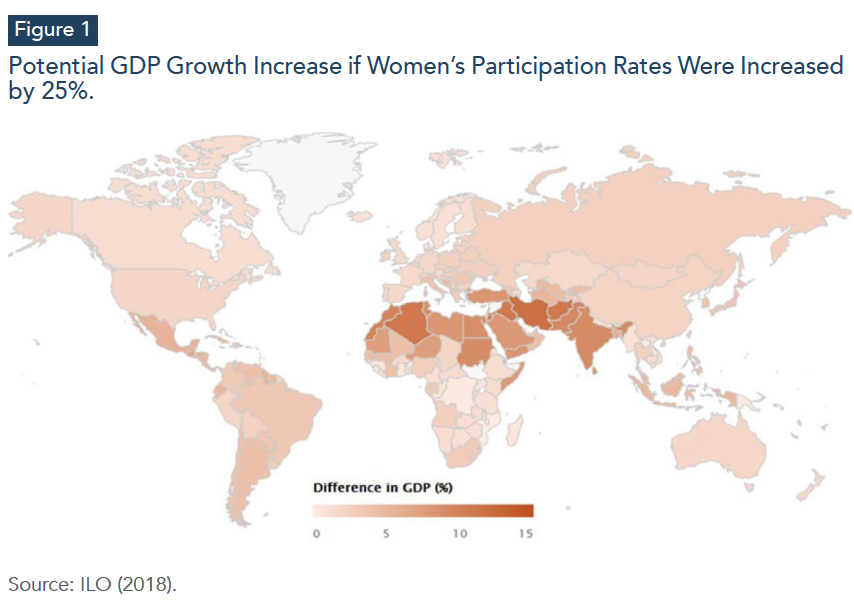
Reducing gender inequality of opportunities has a productivity effect. In 2012, the World Bank (2012) estimated that labor productivity could rise by 25% in some developing countries if barriers to women working in certain sectors or occupations were scrapped. On a related matter, it pointed out that maize yields would rise by almost one-sixth in Malawi and Ghana if women farmers were given the same access as men to fertilizers and other inputs (Canuto, 2021, Ch. 20).
In addition, gender diversity in the workplace is beneficial for productivity growth, with male and female labor inputs complementing each other in the production process. This was demonstrated by Ostry, Espinoza & Papageorgiou (2018), who found that closing gender gaps in the workforce can lead to higher growth and productivity and increase real income for both men and women.
To demonstrate their point, the authors develop a model with a labor force disaggregated by gender to estimate the elasticity of substitution between men and women. The study yielded outcomes that indicate significant complementarities between male and female labor inputs. The production function thus differentiates between female and male in terms of labor inputs, unlike standard models that tend to misattribute some of the rise in productivity growth to technology. Additionally, impediments that obstruct women’s participation in the workforce are associated with substantial costs. These costs are found to be steeply elevated in the MENA and South Asian regions, amounting to an estimated equivalent of up to 50 percent tax rates on female labor (Figure 2).
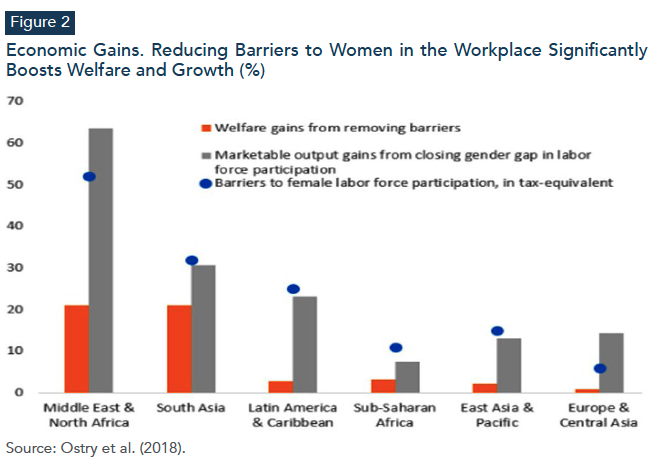
Legal reforms empowering women have stalled
Some aspects of gender inequality in developing economies—like educational enrolment and labor force participation—have diminished during the last few decades. Formal rights and constitutional guarantees for women have advanced in some countries. However, there is still much scope to boost economic growth through policies orientated toward reducing inequality.
Formal and informal gender-specific barriers in nearly every country limit women’s full participation in the labor force and earning potentialalmost every. Legal reforms are of the essence in that regard. Equal treatment of women under the law is highly correlated with larger numbers of women entering and staying in the labor force, including climbing to managerial positions. It makes possible higher wages for women and more women owning a business.
Through its annual report on « Women, Business and the Law », the World Bank (2023) has been tracking laws and regulations on women’s economic participation in 190 economies, with information ranging back to 1970. The objective is to collect and organize measurable benchmarks for evaluating global progress toward legal gender equality.
According to its latest report, on a global average, women enjoy only 77 percent of men’s legal rights . Close to 2.4 billion working-age women around the world live in economies where they do not have the same rights as men. Despite the progress in recent decades, much remains to be done. The latest report has also shown that, in 2022, the global pace of reforms toward equal treatment of women under the law has bottomed to a 20-year low. Gender inequality in Morocco’s labor market
As highlighted earlier, the participation of women in the labor force in Morocco and other MENA countries is among the lowest globally, with rates ranging from 20-30%. In Morocco, female labor force participation has declined by 24% since 2000, while men’s employment rates have only dropped by 4% (Bargain & Bue, 2021). Morocco’s FLFP rate stood at 21.6% in 2018, ranking the country 180th out of a sample of 189 countries (Lopez-Acevedo, Devoto, Morales & Roche Rodriguez, 2021).
Despite recent improvements in women’s educational attainment, their participation in the Moroccan labor force remains restricted. They mostly occupy low-productivity sectors and low-paying jobs that require low skills. This gender gap is more pronounced in urban areas, where the male activity rate is over three times higher than the female rate, compared to rural areas, where the male rate is only just over twice as high as the female rate (Berahab, Bouba & Agénor, 2017).
In addition to gender-based discrimination in economic activity that results in low rates of FLFP, women encounter obstacles in accessing employment, which are manifested in high unemployment rates, particularly among educated women. Over the period 1999-2014, the gap between the unemployment rates of women (22.8%) and men (14.9%) averaged approximately 8 percentage points.
Unemployment is concentrated mainly among graduates, with highly educated women comprising 50% of unemployed individuals with higher education degrees. Despite the increased accessibility of education to women, the participation rate among educated women in the labor market has declined over time. (Lopez-Acevedo, Devoto, Morales & Roche Rodriguez, 2021).
Regarding the wage gap, significant gender-based disparities have persisted despite advancements since the 1990s. As per a Douidich (2011) study, the wage gap in Morocco between men and women was 56% in 1991 and 28% in 1999, and subsequently declined to 17% in 2007. However, the magnitude of these differences varies substantially based on the place of residence and individual characteristics. A predominant portion of the wage gap, approximately 63.8%, can be attributed to salary discrimination against women. (Berahab, Bouba & Agénor, 2017).
Sectoral Distribution of Women in the Labor Market
Regarding sectoral distribution, Moroccan women’s employment exhibits a distinct pattern compared to neighboring countries such as Tunisia or Egypt and the wider MENA region, wherein women have higher representation in the service sector. As Bargain and Bue (2021) reported, Moroccan women are predominantly employed in the agricultural sector, while men are primarily engaged in the service sector. In particular, the primary sector, comprising agriculture, forestry, and fishing, has a marked female presence, with approximately 60% of the total number of employed women compared to 36.6% among men. Furthermore, women demonstrate higher participation in industries, constituting 15.3% of the industry’s workforce compared to 11.6% for men. Notably, the textile, knitwear, clothing, footwear, and leather goods industries featured a predominant female presence, accounting for almost 78.5% of all women employed in manufacturing industries between 1999 and 2013.
However, this strong presence of women in the primary sector also makes them more vulnerable to external contingencies, such as climate variations and fluctuations in global demand, increasing their vulnerability to layoffs. (Berahab, Bouba, and Agénor, 2017). On the other hand, only 8.1% of working women are employed in the service sector, compared to 34% of men (Bargain and Bue, 2021). This striking difference can partly be attributed to gender disparities in education and training, which limit women’s access to skills necessary for high-paying service sector jobs. Additionally, female representation among business owners in Morocco is limited to less than 7%, and the proportion of female leaders among these firms is only 1%, as opposed to 37% and 18% worldwide, respectively (Berahab, Bouba & Agénor, 2017).
Factors Underlying Low FLFP in Morocco
Women in Morocco continue to face a range of barriers that limit their participation in the workforce. These obstacles are multifaceted and include gender norms, the legal framework, and structural and demographic factors. Women are expected to prioritize domestic work and take care of children, while men are the primary breadwinners. These norms are reinforced by the discriminatory hiring practices that women face when attempting to enter the workforce. (Lopez-Acevedo, Devoto, Morales & Roche Rodriguez, 2021).
Education is another critical factor. The low levels of education among women in Morocco, coupled with the lack of alignment between their qualifications and the demands of the labor market, further constrain their access to employment opportunities (Bargain & Bue, 2021). Additionally, demographic factors such as the number of children and marital status contribute to women’s lower labor force participation rates . Data from the National Time Use Survey (ENBT 2011/2012) provides additional information on the unequal distribution of domestic work between the sexes, with women dedicating seven times more time to domestic activities than men. In addition, the survey highlights the lower participation of women in professional life compared to men (Berahab, Bouba & Agénor, 2017).
Quantifying the Potential Economic Benefits of Closing the Gender Employment Gap in Morocco
The study by Bargain and Bue (2021) aimed to estimate the potential impact of increasing female participation in the Moroccan economy through macroeconomic simulations. The simulations were first conducted on the industrial sector and then expanded to include all sectors, with comparable outcomes. In the first scenario, a 25% reduction in the gender employment gap would result in a 5-9% increase in industrial GDP, while a 50% reduction would lead to a 10-15% surge, and complete closure of the gender gap would result in a 17-24% increase in industrial GDP. The second simulation was based on the approach of Ostry et al. (2018), which considers men and women to be complementary in terms of productivity. The multi-sector model found similar outcomes, with a 4-5% increase in GDP from closing the gap by one-quarter in any sector, and a 7-10% increase from closing the gap in all sectors at once, with a potential 25-30% increase in GDP from closing the gender gap across all sectors (Bargain & Bue, 2021).
Morocco in the World Bank’s “Women, Business and the Law”
The World Bank’s “Women, Business and the Law” report scores 190 countries on eight related areas: Mobility, Workplace, Pay, Marriage, Parenthood, Entrepreneurship, Assets, and Pension. They reflect the life cycle of a working woman. In total, 35 questions are scored across eight indicators. Overall scores are then calculated by taking the average of each indicator, with 100 representing the highest possible score.
Based on this approach, Morocco scores 75.6 out of 100, while the global average is 77.1.
Figure 3 exhibits regional averages and the dispersion of scores around them. Economies with average scores above the global average tend to be in OECD high-income, Europe and Central Asia, and Latin America and the Caribbean regions. South Asia and MENA (Middle East and North Africa) have the lowest average scores. The overall score for Morocco is higher than the regional average observed across the Middle East and North Africa (53.2).
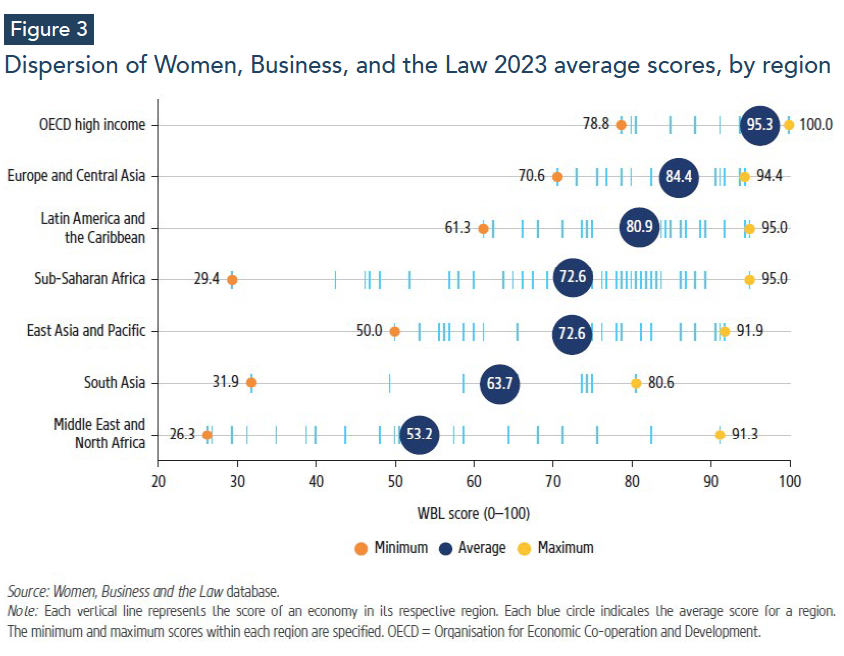
Morocco obtains a perfect score on constraints on freedom of movement, laws affecting women’s decisions to work, and constraints on women starting and running a business. On the other hand, according to the report:
“When it comes to laws affecting women’s pay, constraints related to marriage, laws affecting women’s work after having children, gender differences in property and inheritance, and laws affecting the size of a woman’s pension, Morocco could consider reforms to improve legal equality for women.
For example, one of the lowest scores for Morocco is on the indicator measuring gender differences in property and inheritance. To improve on the Assets indicator, Morocco may wish to consider equalizing inheritance rights for sons and daughters, equalizing inheritance rights for male and female surviving spouses, and recognizing the value of nonmonetary contributions.”
CONCLUDING REMARKS
Like in most countries, there is a clear agenda on what Morocco can do to reduce gender inequality in the labor market and in other economic areas. Morocco’s productivity and economic performance would benefit.
References
-
Agenor, P.-R.; Canuto, O.; and Pereira da Silva, L.A. (2014). On gender and growth: The role of intergenerational health externalities and women’s occupational constraints. Structural Change and Economic Dynamics, Volume 30, September, (p. 132-147).
-
Agenor, P.-R. and Canuto, O. (2015). Gender equality and economic growth in Brazil: A long-run analysis. Journal of Macroeconomics, vol. 43, March, (p. 155-172).
-
Bargain, O., & Bue, M. L. (2021). Coûts Économiques des Inégalités de genre dans le Marché du Travail au Maroc. Commissioned by ONU Femmes Maroc and Centre d’Excellence pour la Budgétisation Sensible au Genre (CE-BSG). Rabat: Direction des Études et des Prévisions Financières (DEPF) and ONU Femmes Maroc.
-
Berahab, R., Bouba, Z., & Agénor, P. R. (2017). Egalité de genre, politiques publiques et croissance économique au Maroc. Books & Reports. Direction des Études et des Prévisions Financières (DEPF) and Policy Center for the New South.
-
Blau, F. D., & Kahn, L. M. (2017). The gender wage gap: Extent, trends, and explanations. Journal of economic literature, 55(3), 789-865.
-
Canuto, O. (2021). Climbing a high ladder: development in the global economy. Policy Center for the New South.
-
Douidich, M. (2011). Inégalités des salaires hommes-femmes, 1991-2007: tendances, origines et femmes cibles, Cahiers du Plan, N°36, juillet-août 2011, Haut-Commissariat au Plan
-
ILO - International Labour Organization (2017). Women and men in the informal economy: A statistical picture (3rd ed.).
-
ILO - International Labor Organization (2018). Trends for Women 2018 – Global Snapshot, Geneva.
-
ILO - International Labour Organization. (2021). Barriers and challenges to women’s labor force participation. ILO InfoStories.
-
ILO - International Labour Organization. (2023). World Employment and Social Outlook: Trends 2023.
-
Lopez-Acevedo, G., Devoto, F., Morales, M., & Roche Rodriguez, J. (2021). Trends and determinants of female labor force participation in Morocco: An initial exploratory analysis. IZA Institute of Labor Economics, IZA DP No. 14218.
-
OECD. (2019). Changing laws, breaking barriers: Women’s economic activity in the Middle East and North Africa.
-
Ostry, M. J. D., Alvarez, J., Espinoza, M. R. A., & Papageorgiou, M. C. (2018). Economic gains from gender inclusion: New mechanisms, new evidence. International Monetary Fund, Staff Discussion Notes No. 2018/006.
-
Weichselbaumer, D., & Winter-Ebmer, R. (2005). A meta-analysis of the international gender wage gap. Journal of economic surveys, 19(3), 479-511.
-
World Bank (2012). World Development Report 2012: Gender Equality and Development. World Bank.
-
World Bank. (2022). Women’s labor force participation data story. Gender Data Portal.
-
World Bank (2023). Women, Business and the Law 2023, World Bank.

